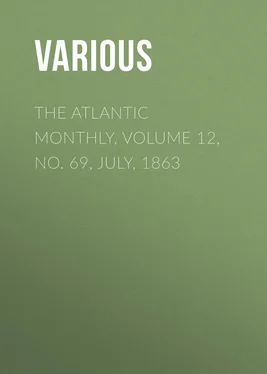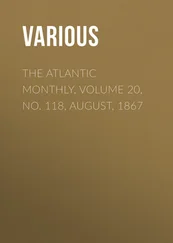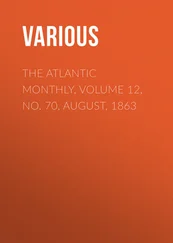Various - The Atlantic Monthly, Volume 12, No. 69, July, 1863
Здесь есть возможность читать онлайн «Various - The Atlantic Monthly, Volume 12, No. 69, July, 1863» — ознакомительный отрывок электронной книги совершенно бесплатно, а после прочтения отрывка купить полную версию. В некоторых случаях можно слушать аудио, скачать через торрент в формате fb2 и присутствует краткое содержание. Жанр: foreign_antique, periodic, foreign_edu, на английском языке. Описание произведения, (предисловие) а так же отзывы посетителей доступны на портале библиотеки ЛибКат.
- Название:The Atlantic Monthly, Volume 12, No. 69, July, 1863
- Автор:
- Жанр:
- Год:неизвестен
- ISBN:нет данных
- Рейтинг книги:4 / 5. Голосов: 1
-
Избранное:Добавить в избранное
- Отзывы:
-
Ваша оценка:
- 80
- 1
- 2
- 3
- 4
- 5
The Atlantic Monthly, Volume 12, No. 69, July, 1863: краткое содержание, описание и аннотация
Предлагаем к чтению аннотацию, описание, краткое содержание или предисловие (зависит от того, что написал сам автор книги «The Atlantic Monthly, Volume 12, No. 69, July, 1863»). Если вы не нашли необходимую информацию о книге — напишите в комментариях, мы постараемся отыскать её.
The Atlantic Monthly, Volume 12, No. 69, July, 1863 — читать онлайн ознакомительный отрывок
Ниже представлен текст книги, разбитый по страницам. Система сохранения места последней прочитанной страницы, позволяет с удобством читать онлайн бесплатно книгу «The Atlantic Monthly, Volume 12, No. 69, July, 1863», без необходимости каждый раз заново искать на чём Вы остановились. Поставьте закладку, и сможете в любой момент перейти на страницу, на которой закончили чтение.
Интервал:
Закладка:
Still another application of photography, becoming every day more and more familiar to the public, is that which produces enlarged portraits, even life-size ones, from the old daguerreotype or more recent photographic miniature. As we have seen this process, a closet is arranged as a camera-obscura, and the enlarged image is thrown down through a lens above on a sheet of sensitive paper placed on a table capable of being easily elevated or depressed. The image, weakened by diffusion over so large a space, prints itself slowly, but at last comes out with a clearness which is surprising,—a fact which is parallel to what is observed in the stereoscopticon, where a picture of a few square inches in size is "extended" or diluted so as to cover some hundreds of square feet, and yet preserves its sharpness to a degree which seems incredible.
The copying of documents to be used as evidence is another most important application of photography. No scribe, however skilful, could reproduce such a paper as we saw submitted to our fellow-workman in Mr. Black's establishment the other day. It contained perhaps a hundred names and marks, but smeared, spotted, soiled, rubbed, and showing every awkward shape of penmanship that a miscellaneous collection of half-educated persons could furnish. No one, on looking at the photographic copy, could doubt that it was a genuine reproduction of a real list of signatures; and when half a dozen such copies, all just alike, were shown, the conviction became a certainty that all had a common origin. This copy was made with a Harrison's globe lens of sixteen inches' focal length, and was a very sharp and accurate duplicate of the original. It is claimed for this new American invention that it is "quite ahead of anything European"; and the certificates from the United States Coast-Survey Office go far towards sustaining its pretensions.
Some of our readers are aware that photographic operations are not confined to the delineation of material objects. There are certain establishments in which, for an extra consideration, (on account of the difficilis ascensus , or other long journey they have to take,) the spirits of the departed appear in the same picture which gives the surviving friends. The actinic influence of a ghost on a sensitive plate is not so strong as might be desired; but considering that spirits are so nearly immaterial, that the stars, as Ossian tells us, can be seen through their vaporous outlines, the effect is perhaps as good as ought to be expected.
Mrs. Brown, for instance, has lost her infant, and wishes to have its spirit-portrait taken with her own. A special sitting is granted, and a special fee is paid. In due time the photograph is ready, and, sure enough, there is the misty image of an infant in the background, or, it may be, across the mother's lap. Whether the original of the image was a month or a year old, whether it belonged to Mrs. Brown or Mrs. Jones or Mrs. Robinson, King Solomon, who could point out so sagaciously the parentage of unauthenticated babies, would be puzzled to guess. But it is enough for the poor mother, whose eyes are blinded with tears, that she sees a print of drapery like an infant's dress, and a rounded something, like a foggy dumpling, which will stand for a face: she accepts the spirit-portrait as a revelation from the world of shadows. Those who have seen shapes in the clouds, or remember Hamlet and Polonius, or who have noticed how readily untaught eyes see a portrait of parent, spouse, or child in almost any daub intended for the same, will understand how easily the weak people who resort to these places are deluded.
There are various ways of producing the spirit-photographs. One of the easiest is this. First procure a bereaved subject with a mind "sensitized" by long immersion in credulity. Find out the age, sex, and whatever else you can, about his or her departed relative. Select from your numerous negatives one that corresponds to the late lamented as nearly as may be. Prepare a sensitive plate. Now place the negative against it and hold it up close to your gas-lamp, which may be turned up pretty high. In this way you get a foggy copy of the negative in one part of the sensitive plate, which you can then place in the camera and take your flesh-and-blood sitter's portrait upon it in the usual way. An appropriate background for these pictures is a view of the asylum for feeble-minded persons, the group of buildings at Somerville, and possibly, if the penitentiary could be introduced, the hint would be salutary.
The number of amateur artists in photography is continually increasing. The interest we ourselves have taken in some results of photographic art has brought us under a weight of obligation to many of them which we can hardly expect to discharge. Some of the friends in our immediate neighborhood have sent us photographs of their own making which for clearness and purity of tone compare favorably with the best professional work. Among our more distant correspondents there are two so widely known to photographers that we need not hesitate to name them: Mr. Coleman Sellers of Philadelphia and Mr. S. Wager Hull of New York. Many beautiful specimens of photographic art have been sent us by these gentlemen,—among others, some exquisite views of Sunnyside and of the scene of Ichabod Crane's adventures. Mr. Hull has also furnished us with a full account of the dry process, as followed by him, and from which he brings out results hardly surpassed by any method.
A photographic intimacy between two persons who never saw each other's faces (that is, in Nature's original positive, the principal use of which, after all, is to furnish negatives from which portraits may be taken) is a new form of friendship. After an introduction by means of a few views of scenery or other impersonal objects, with a letter or two of explanation, the artist sends his own presentment, not in the stiff shape of a purchased carte de visite , but as seen in his own study or parlor, surrounded by the domestic accidents which so add to the individuality of the student or the artist. You see him at his desk or table with his books and stereoscopes round him; you notice the lamp by which he reads,—the objects lying about; you guess his condition, whether married or single; you divine his tastes, apart from that which he has in common with yourself. By-and-by, as he warms towards you, he sends you the picture of what lies next to his heart,—a lovely boy, for instance, such as laughs upon us in the delicious portrait on which we are now looking, or an old homestead, fragrant with all the roses of his dead summers, caught in one of Nature's loving moments, with the sunshine gilding it like the light of his own memory. And so these shadows have made him with his outer and his inner life a reality for you; and but for his voice, which you have never heard, you know him better than hundreds who call him by name, as they meet him year after year, and reckon him among their familiar acquaintances.
To all these friends of ours, those whom we have named, and not less those whom we have silently remembered, we send our grateful acknowledgments. They have never allowed the interest we have long taken in the miraculous art of photography to slacken. Though not one of them may learn anything from this simple account we have given, they will perhaps allow that it has a certain value for less instructed readers, in consequence of its numerous and rich omissions of much which, however valuable, is not at first indispensable.
THE WRAITH OF ODIN
The guests were loud, the ale was strong,
King Olaf feasted late and long;
The hoary Scalds together sang;
O'erhead the smoky rafters rang.
Dead rides Sir Morten of Fogelsang.
The door swung wide, with creak and din;
A blast of cold night-air came in,
And on the threshold shivering stood
An aged man, with cloak and hood.
Dead rides Sir Morten of Fogelsang.
Интервал:
Закладка:
Похожие книги на «The Atlantic Monthly, Volume 12, No. 69, July, 1863»
Представляем Вашему вниманию похожие книги на «The Atlantic Monthly, Volume 12, No. 69, July, 1863» списком для выбора. Мы отобрали схожую по названию и смыслу литературу в надежде предоставить читателям больше вариантов отыскать новые, интересные, ещё непрочитанные произведения.
Обсуждение, отзывы о книге «The Atlantic Monthly, Volume 12, No. 69, July, 1863» и просто собственные мнения читателей. Оставьте ваши комментарии, напишите, что Вы думаете о произведении, его смысле или главных героях. Укажите что конкретно понравилось, а что нет, и почему Вы так считаете.












